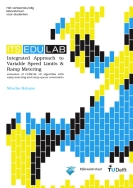Traffic congestion continues to remain a serious problem in most countries, with significant economic and environmental losses. ‘Intelligent Transport Systems (ITS)’ that utilize advanced information and communication technology for managing road infrastructure, including vehicles and users, have shown great potential in dealing with this problem. However, most current traffic management measures, like route guidance, ramp metering and variable speed limits are designed and implemented independently. Potentially counter-productive when deployed simultaneously, integration of these measures can benefit from synergic effects. The aim of this work is to integrate a near-future variable speed control strategy with ramp metering, to operate efficiently at a freeway merging section.
It is seen that optimization-based integration strategies may offer huge potential to improve freeway efficiency but these strategies are computationally complex for systems available in practice. Therefore, a sophisticated reactive variable speed limits strategy – COoperative Speed Control ALgorithm (COSCAL v2) is chosen for integration with ramp metering. COSCAL v2 is a counteractive control strategy that resolves moving jams to recover loss in efficiency from capacity drop. It uses shockwave theory concepts to speed limit the exact the number of vehicles required to first resolve a jam, and next, to stabilize the traffic while recovering traffic throughput. However, this approach is not feasible for time-dependent ramp metering flows. Therefore, in the advanced strategy the theory of COSCAL v2 is extended for compatibility to a more sophisticated ramp metering approach. Further, a new ramp metering strategy using cumulative curves is developed to include: queue-length constraints; policy restrictions on ramp metering flows; and limitations on the minimum freeway flow that can be achieved with speed limits given the traffic state measurements. One of the main advantages of the advanced strategy is its responsiveness to changing ramp flows, and the utilization of freeway speed-limitation to prevent a queue spillback on the ramp.
The control strategy thus developed is tested by means of simulation. Simulation runs under different demand conditions are performed to verify the behavioural performance of the approach. Jam waves – that otherwise occur when ramp metering and COSCAL v2 are implemented independently – are prevented in the integrated approach. The results offer an initial indication of potential improvement from the strategy. However, a more comprehensive quantitative evaluation is recommended. Furthermore, some critical developments to the approach following the simulation study are identified. In conclusion, this work demonstrates two ways in which COSCAL v2 can be integrated with ramp metering (RM); how cumulative curves can be used for integration of control measures; and how efficiency gains on the freeway and urban network can be balanced. The simulations offer a proof of concept for the working of the advanced integrated strategy. However, the basic strategy should be both implemented and tested further.
